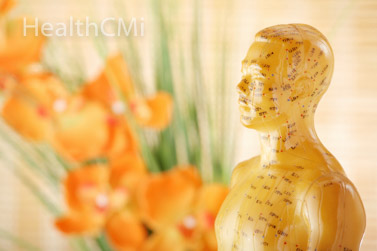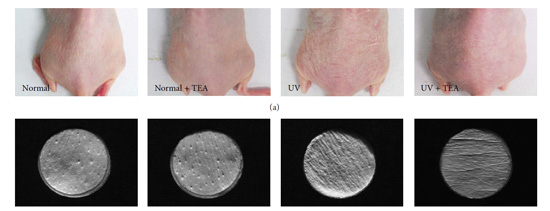Acupuncture protects the skin from ultraviolet radiation damage, decreases wrinkle formation, and inhibits degradation of collagen fibers. Researchers investigated the effects of thread embedded acupuncture (TEA) in a dermatological laboratory experiment on laboratory mice.  Benefits to the skin were confirmed with histopathological measurements and zymography, an electrophoretic technique for documenting proteolytic activity. In addition, visible skin changes were documented using photography.
Benefits to the skin were confirmed with histopathological measurements and zymography, an electrophoretic technique for documenting proteolytic activity. In addition, visible skin changes were documented using photography.
The photographic and laser scanning microscopic images were striking. The control group mice receiving only ultraviolet B (UVB) exposure showed significantly greater skin damage than mice receiving UVB exposure combined with absorbable thread embedded acupuncture. Immunohistochemistry, zymography, histological analysis, and collagen staining confirm that embedded acupuncture protects the skin from UVB damage. Using the aforementioned techniques, the researchers were able to identify key mechanisms by which acupuncture exerted its therapeutic effects.
The researchers note that acupuncture “is effective in suppressing signs of photoaging including epidermal thickness and collagen fiber loss. In addition, TEA exerts its photoprotective effects against UVB irradiated skin damage by inhibiting JNK activation with subsequent reduction in MMP-9 expression.” Levels of pJNK and MMP-9 were significantly reduced using thread embedded acupuncture (TEA). The researchers note that TEA may have tightened lax skin and prevented wrinkles due to its lasting stimulatory effects on collagen fiber formation due to downregulation of JNK and MMM-9.
The researchers note that MMP-9 (matrix metallopeptidase), an enzyme that breaks down extracellular matrix and is involved in tissue remodeling, “plays a major role in the final degradation of cleaved collagen into gelatin and small peptides, a major factor responsible for wrinkle formation.” In this experiment, excessive amounts of MMPs were secreted due to UVB stimulation of keratinocytes, fibroblasts, and inflammatory related cells. The thread embedded acupuncture alleviated the “gelatinolytic activity of MMP-9 and subsequent alleviation of collagen loss.”
Acupuncture’s ability to downregulate MMP-9 in the presence of excessive MMP-9 expression implies a homeostatic response because additional research demonstrates that acupuncture can upregulate MMP-9. Researchers found that acupuncture applied to acupoints LR3 (Taichong), LR14 (Qimen), UB18 (Ganshu), and ST36 (Zusanli) alleviates hepatic fibrosis. Examination of hepatocyte arrangement, necrosis, and hepatic pseudo-lobular formation confirms that acupuncture ameliorates hepatic fibrosis.
MMP-9 protein expression from hematopoietic stem cells were “upregulated remarkably in the acupuncture group” compared with the sham control group. The acupuncture group showed additional significant changes related to the alleviation of liver fibrosis including changes in collagen, fibronectin proteins, TIMP-1 (a tissue inhibitor of metalloproteinases), serum hyaluronic acid, laminin, and several other endogenous secretions.
The contrasting findings of MMP-9 upregulation in one study and downregulation in another are not unusual or contradictory. Different types of acupuncture styles and acupoint selections were used. Additionally, research repeatedly documents that acupuncture upregulates expression of deficient biochemicals while downregulating expression of excessive biochemicals. The following images from the study show the visible skin condition and wrinkle formation of UVB induced skin damage in mice receiving thread embedded acupuncture (TEA) and mice receiving no treatment. The before and after images help to gain an visual understanding of the results.

References:
Kim, Yoon-Jung, Ha-Neui Kim, Mi-Sook Shin, and Byung-Tae Choi. "Thread embedding acupuncture inhibits ultraviolet B irradiation-induced skin photoaging in hairless mice." Evidence-Based Complementary and Alternative Medicine, v. 2015, article ID 539172, 9 p. dx.doi.org/10.1155/2015/539172.
Acupuncture Research. Inhibitory Effect of Acupuncture on Hepatic Extracellular Matrix Production in Carbon Tetrachloride-induced Liver Fibrosis Rats. 2012-01. ZHANG Feng, LU Yin, NI Guang-xia, NI Chun-yan, ZHANG Xue-jiao,WANG Ai-yun, ZHENG Shi-zhong.


